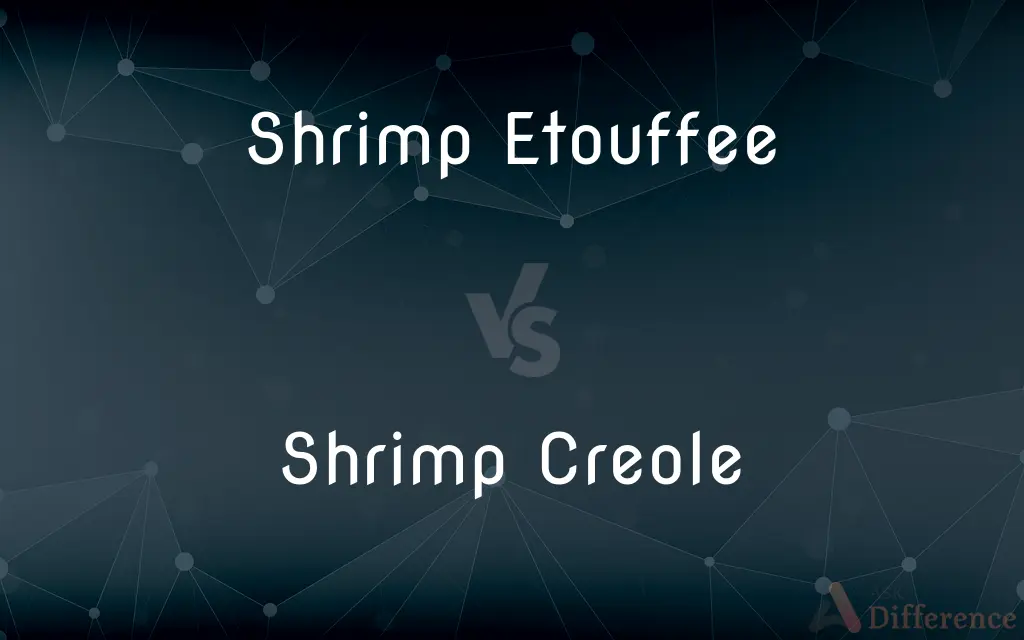Shrimp Etouffee vs. Shrimp Creole — What's the Difference?
Edited by Tayyaba Rehman — By Fiza Rafique — Published on December 6, 2023
Shrimp Etouffee is a thick, roux-based stew, while Shrimp Creole features a tomato-based sauce; both are classic Louisiana dishes.

Difference Between Shrimp Etouffee and Shrimp Creole
Table of Contents
ADVERTISEMENT
Key Differences
Shrimp Etouffee and Shrimp Creole are both beloved dishes hailing from Louisiana. Shrimp Etouffee's foundation is built upon a roux, which is a mixture of fat and flour, giving the dish its characteristic thick, rich gravy. Shrimp Creole, contrastingly, celebrates the brightness of tomatoes, which form the base of its sauce.
At their core, Shrimp Etouffee and Shrimp Creole prominently feature shrimp, a staple seafood of the region. Yet, their flavor profiles diverge because of the other ingredients they're combined with. Shrimp Etouffee generally exudes a deeper, earthy taste due to its roux base and the Holy Trinity (bell peppers, onions, and celery). In comparison, Shrimp Creole tends to be tangier and slightly acidic because of its tomato prominence.
When delving into the culinary history, Shrimp Etouffee has its roots in the rural, Cajun communities of Louisiana. Its name "etouffee" translates to "smothered" or "suffocated," fittingly describing how the shrimp is enveloped in its sauce. Shrimp Creole, conversely, finds its origin in the urban Creole culture of New Orleans, with its name reflecting this heritage.
In terms of presentation and serving, Shrimp Etouffee is typically heftier, served over rice, allowing the grains to soak up its rich sauce. Shrimp Creole, on the other hand, can also be served over rice, but its lighter, tomato-based sauce offers a different kind of pairing pleasure.
Comparison Chart
Base of the Dish
Roux (fat and flour mixture)
Tomatoes
ADVERTISEMENT
Flavor Profile
Deeper, earthy
Tangier, slightly acidic
Cultural Origin
Rural Cajun communities of Louisiana
Urban Creole culture of New Orleans
Translation/ Meaning
"Smothered" or "Suffocated"
Reflects Creole heritage
Typical Serving
Hefty, over rice
Over rice, with a lighter sauce
Compare with Definitions
Shrimp Etouffee
Cajun dish with earthy flavors.
I crave the deep flavors of Shrimp Etouffee during winter.
Shrimp Creole
A tomato-based Louisiana dish.
The tanginess of the Shrimp Creole was refreshing.
Shrimp Etouffee
A roux-based Louisiana stew.
She savored every bite of the rich Shrimp Etouffee.
Shrimp Creole
Emphasizes Creole culinary traditions.
Shrimp Creole is a testament to New Orleans' rich culinary history.
Shrimp Etouffee
Features shrimp smothered in thick sauce.
The Shrimp Etouffee at the restaurant was exceptionally creamy.
Shrimp Creole
Features shrimp in a tangy sauce.
He loved the acidic kick of the Shrimp Creole.
Shrimp Etouffee
Served prominently over rice.
The rice paired perfectly with the Shrimp Etouffee's gravy.
Shrimp Creole
A staple of urban Creole culture.
New Orleans' restaurants often serve classic Shrimp Creole.
Shrimp Etouffee
Originates from rural Louisiana.
Authentic Shrimp Etouffee recipes have been passed down in Cajun families.
Shrimp Creole
Often served over rice.
The light sauce of the Shrimp Creole complemented the rice.
Common Curiosities
Which dish originates from the Creole culture of New Orleans?
Shrimp Creole originates from the urban Creole culture of New Orleans.
Which dish has a deeper, earthier flavor profile?
Shrimp Etouffee generally has a deeper, earthy flavor profile.
What does the name "etouffee" mean?
"Etouffee" translates to "smothered" or "suffocated."
Do both dishes prominently feature shrimp?
Yes, both Shrimp Etouffee and Shrimp Creole prominently feature shrimp.
Is the sauce of Shrimp Creole heavy?
No, Shrimp Creole has a lighter, tomato-based sauce.
What is the base for Shrimp Etouffee?
Shrimp Etouffee is based on a roux, which is a mixture of fat and flour.
Which dish has its roots in rural Cajun communities?
Shrimp Etouffee has its roots in the rural Cajun communities of Louisiana.
Does Shrimp Etouffee always use a roux?
Traditionally, Shrimp Etouffee uses a roux as its base, but variations may exist.
How about Shrimp Creole's base?
Shrimp Creole features a tomato-based sauce.
Is Shrimp Etouffee typically thick or light?
Shrimp Etouffee is typically thick, with a rich gravy.
What is the typical serving base for Shrimp Creole?
Shrimp Creole is often served over rice with its light, tomato-based sauce.
Are both dishes typically spicy?
Both dishes can have a kick, but the level of spiciness can vary based on the recipe and personal preference.
Which dish is tangier due to its tomato prominence?
Shrimp Creole tends to be tangier because of its tomato prominence.
Can I find Shrimp Etouffee in New Orleans' restaurants?
Yes, while Shrimp Etouffee has rural Cajun origins, it's also popular in New Orleans' restaurants.
Which dish is a testament to New Orleans' culinary heritage?
Shrimp Creole is a testament to New Orleans' rich Creole culinary heritage.
Share Your Discovery

Previous Comparison
Pangolins vs. Anteaters
Next Comparison
Microsoft Yammer vs. Facebook WorkplaceAuthor Spotlight
Written by
Fiza RafiqueFiza Rafique is a skilled content writer at AskDifference.com, where she meticulously refines and enhances written pieces. Drawing from her vast editorial expertise, Fiza ensures clarity, accuracy, and precision in every article. Passionate about language, she continually seeks to elevate the quality of content for readers worldwide.
Edited by
Tayyaba RehmanTayyaba Rehman is a distinguished writer, currently serving as a primary contributor to askdifference.com. As a researcher in semantics and etymology, Tayyaba's passion for the complexity of languages and their distinctions has found a perfect home on the platform. Tayyaba delves into the intricacies of language, distinguishing between commonly confused words and phrases, thereby providing clarity for readers worldwide.
















































